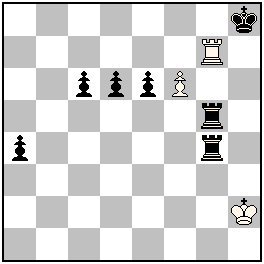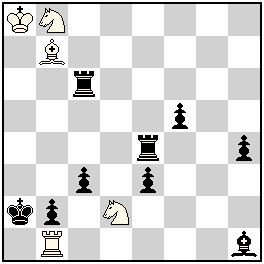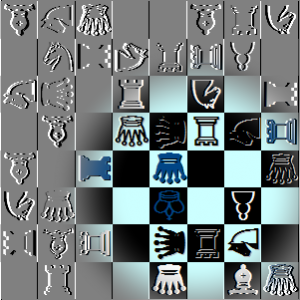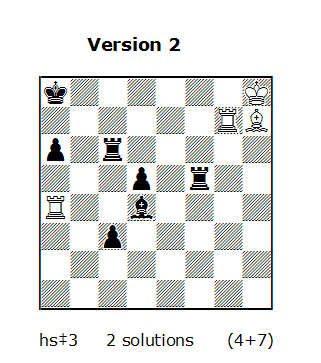|
|
Original Problems (page 62)Original fairy problems published during 2012 will participate in the informal tourney JF-2012. The site is mostly about fairies, but h# and s# are also welcomed for publication! Please send your problems to my e-mail: julia@juliasfairies.com Go to →List of Problems ; →Page 61 ; →Page 63 |
Warm welcome to well-known Macedonian composer and editor of magazine Vratniza-64 – Bosko Miloseski!
No.118 – hs#3 – Fine line-combinations, executed by the white Rook in cooperation with black “colleagues”. (JV)
No.118.1 – hs#3 – And this is a very nice improvement to No.118, coming after about 2,5 months and based on the comments to the 1st version. I’m happy to publish it here as well! (JV)
You can сlick on “Solutions” to show or hide the solutions!
|
No.118 Bosko Miloseski
Macedonia
original – 28.08.2012
 hs#3 b) pc6→d5 (3+7)
Solution: (click to show/hide)
|
No.118.1 Bosko Miloseski
Macedonia
original – 11.11.2012
 hs#3 2 solutions (5+9)
Solution: (click to show/hide)
|
The diagrams are made on WinChloe and its Echecs font is used for Logo design



Twin form seems to be unnecessary. What about the following version?
White Rg7 Pf6 Kh1
Black Kh8 Pc5 Rg5 Pd4 Pe4 Rg3
hs#3
2.1.1.1.1.1
Look at the original and your position without wR.
(A Bristol is visible in both solutions.)
Bristol? Cant see it unless you mean W3 and B3 of the solutions.
You’re right! 1…Rg5-g8 2…Rg3-g6 is not a Bristol!
This is a big mistake from me!
White Pf6 Kh1
Black Kh8 Pc5 Rg5 Pd4 Pe4 Rg3
hs#3
1.f6-f7 Rg5-g8 2.f7-f8=Q Rg3-g6 3.Qf8-h6 + Rg6*h6 #
Black-White Brunner-Turton [see: Petrovic-Sahovski problem, 1949]
No.118 Bosko Miloseski [/img]
[/img]
I think that the main question here is not the name of the theme. It’s not so important how we can call it. The problem № 118 has a very significant defect, that in my opinion, essentially reduces its evaluation. It is a repetition of black blocking – moves with black Rooks on g8. This defect should be avoided at all costs, before we think about other improvements!
Obviously, there’s a lot of possibilities in this aspect, but it is clear – these experiments are difficult and do not lead quickly to the good results.
I’d like to demonstrate here not the best Version of №118, but just some experimental positions. They can be a basis for a more interesting and meaningful versions:
[img
1.Ra4-a2 Rf5-f1 2.Ra2-f2 Rc6-h6 3.Rf2-f8+ Rf1xf8‡
1.Ra4-a5 Rc6-c4 2.Ra5-c5 Rf5-h5 3.Rc5-c8+ Rc4xc8‡
[img [/img]
[/img]
1.Ra4-a2 Rf5-f1 2.Ra2-f2 Rc6-h6 3.Rf2-f8+ Rf1xf8‡
1.Ra4-a5 Rc6-c4 2.Ra5-c5 Rf5-h5 3.Rc5-c8+ Rc4xc8‡
In Version 2 we see two pinned pieces in final position. But I think that it is not an important plus in comparison with Version 1 because here Bh7 is a static pinned piece (as Rg7 of course). If a white piece is static pinned (therefore – it makes not moves in play) we cannot evaluate this pin as a sufficient high plus of a problem (by the by, a technical character has also Bd4).
Static status of Rg7 is also not so pleasant but here this piece keeps squares around the b.K – therefore Rg7 is a better static figure as Bh7. Therefore I think that V1 is better as V2 but the idea for thematic pins with the “Not Turton Rook” deserves interest – probably – in some other positions or even – in problems in 3.5 or 4 moves with additional thematic motives.
hm…. Interesting versions by Petkov. But I thought in the original problem, the blocks on g8 being by different rooks was not a defect.